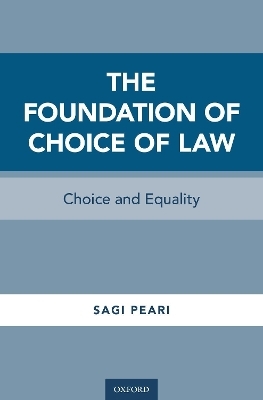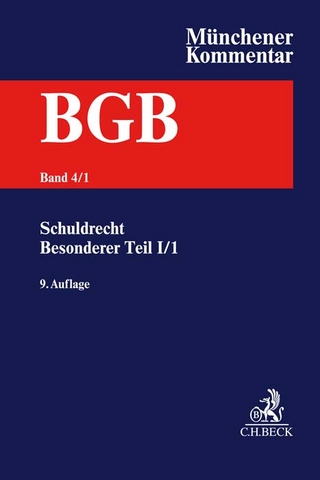
The Foundation of Choice of Law
Oxford University Press Inc (Verlag)
978-0-19-062230-5 (ISBN)
Among other things, this book provides a justification of the nature and limits of such popular principles as party autonomy, most significant relationship, and closest connection. It also discusses such topics as the actual operation of public policy doctrine in domestic courts, and the relation between the notion of international human rights and international commercial dealings, and makes some suggestions about the ability of traditional rules to cope with the advancing challenges of the digital age and the Internet.
Sagi Peari is a Faculty member of Law School at the University of Western Australia. He researches and teaches within private law, commercial law, international law and their intersections. He has published in leading US, Canadian, European and Australian legal journals. Sagi holds a SJD degree from the University of Toronto, where he held the prestigious Joseph-Armand Bombardier and Connaught Doctoral Fellowships. In addition, he was a recipient of a Hauser Global Scholar Fellowship at New York University, a Connection Grant from the Social Sciences and Humanities Research Council of Canada, and has been recognised for his academic contribution by the American Society of International Law.
Acknowledgments
Introduction
I. The Formal Structure of Choice of law Rules: Three Choice of Law Methodologies
A. The Inherently Formal Structure of Classical and Interest Analysis Choice of Law Methodologies
B. Challenging the Formal Structure of Choice of law Rules: Better Law Methodology
1. Better Law: Two Versions and Two Challenges
2. Better Law as a Primary Rule: Robert Leflar & Friedrich Juenger
3. Targeting the Better Law Approach as a Primary Rule
4. Better Law as a Subsidiary Rule
C. Situating CEF within the Formal Structure of Choice of Law Rules and the Better Law Story
II. Choice Pillar I: Understanding Savigny's Theory of Choice of Law as
Voluntary Submission
A. Step 1: Three Basic Insights on the Nature of the Subject
1. Basic Insight (1): The Basic Unit of Inquiry Has to be Related to the Concept of "Legal
Relations"
2. Basic Insight (2): Choice of Law Rules Must Be Linked to States' Territories
3. Basic Insight (3): The Choice of Law System Has to Be Universal
B. Step 2: Theory Revealed - Organizing Principle of "Voluntary Submission"
1. The Relation to Roman Law and the Scholarship of Organizing Principles
2. The Operational Mechanism of the Principle
C. Step III: Two Deviations from the "Voluntary Submission" Principle
1. Deviation I: Savigny's Exceptional Category of "Anomalous Laws"
2. Deviation II: The Frequent Affixation on Juridical Presumptions
III. Choice Pillar II: Returning Savigny's Theory to its Origins
A. The Kantian Origins of Savigny's Organizing Principle of "Voluntary Submission"
1. Kantian System of Right
2. Savigny's System of Rights
B. CEF's Choice Pillar: the Principle of Juridical Relational Choice
1. The Requirement of Juridical Relational Choice
2. The Presence of a Foreign Element in the Factual Matrix of the Case
C. The Operational Mechanics of the Choice Pillar: Party Autonomy and Constructive
Inference
1. Party Autonomy Principle
2. The Doctrine of Constructive Inference
IV. The Equality Pillar
A. The Link to Better Law as a Subsidiary Rule
B. The Limits to Kantian (and CEF's) Positivism: (1) Barbarism; (2) Innate Equality;
and (3) State Equality
1. The Barbarism Exception
2. Innate Equality Exception
3. States' Equality Principle
C. The Two Challenges of Better Law and CEF's Positivism
1. The Subjectivity and Legitimacy Challenges
2. CEF's Positivism
D. Evil Laws as a Reflection of the Equality Pillar
1. The Notion of Evil Laws in Legal Theory
2. Mutual Benefits: What Can Evil Laws and the Equality Pillar Teach Each Other?
E. Public Policy as Equality Pillar in Courts
1. Terminology
2. Loucks v. Standard Oil
3. Oppenheimer v. Cattermole
4. Kuwait Airways v. Iraqi Airways
V. Further Development and Implications
A. Tort Law
1. American Babcock v. Jackson and English Chaplin v. Boys
2. "Conduct Regulating" versus "Loss Distribution" Distinction
3. The Distinction in the New York Court of Appeal
B. Lex Fori as a "Very Dangerous" Solution?
1. Conceptually Different Questions
2. Savigny's Objection to "Choice of Law Shopping"
3. When CEF Cannot Escape lex fori's Application: (1) the classification question; and (2) the lacuna left by the Application of the Equality Pillar
C. Mandatory Rules
1. Mandatory Rules, their Presence in Contemporary Choice of Law Practice, and Scope of CEF's Argument
2. The Genesis of Mandatory Rules within Savigny's Category of "Anomalous" Laws and its
Incompatibility with CEF
3. States' Interests, Lex Fori and the Reasons for Mandatory Rules
4. Mandatory Rules and the Puzzles of Party Autonomy
D. Substance- Procedure Distinction
1. Three Matters
2. Some Thoughts on the Substance-Procedure Distinction
3. Matter I: Challenging the Traditional Right-Remedy Distinction
4. Matter II: Challenging the lex- fori regit processum Doctrine- the State-Based Foundation of Procedural Rules
5. Matter III: Widening the Scope of Public Policy Doctrine
VI. The Relation to Theory & Practice
A. The Relation to Other Choice of Law Accounts
1. Interest Analysis and Better Law
2. Classical Choice of Law Methodology and its Vested Rights Version
3. Legal Realism Criticism and Rules' Manipulation
B. The Relation to Neo-Kantian Theory of Private Law - Corrective Justice
1. Choice & Equality within the Structures of Corrective Justice and CEF
2. CEF's Vision of Choice & Equality
3. The Role of Corrective Justice Within the Operational Mechanism of CEF
C. The Relation to the Notion of Human Rights
D. American Second Restatement
1. General Overview
2. Some Tentative Thoughts on Reciprocal Contribution
E. The Challenge of the Digital Age
1. The Challenge of the Internet
2. Accommodation of Traditional Doctrines
3. CEF's Analysis of Internet Choice of Law Cases
Conclusion
Appendix A: Savigny's Model of Choice-of-Law Rules
Appendix B: CEF's Model of Choice-of-Law Rules
Appendix C: CEF vs. Savigny
Appendix D: CEF vs. Classical, Interest Analysis and Better Law Choice of Law Methodologies
Index
| Erscheinungsdatum | 12.06.2018 |
|---|---|
| Verlagsort | New York |
| Sprache | englisch |
| Maße | 239 x 163 mm |
| Gewicht | 590 g |
| Themenwelt | Recht / Steuern ► Allgemeines / Lexika |
| Recht / Steuern ► EU / Internationales Recht | |
| Recht / Steuern ► Privatrecht / Bürgerliches Recht ► Internationales Privatrecht | |
| ISBN-10 | 0-19-062230-X / 019062230X |
| ISBN-13 | 978-0-19-062230-5 / 9780190622305 |
| Zustand | Neuware |
| Haben Sie eine Frage zum Produkt? |
aus dem Bereich


